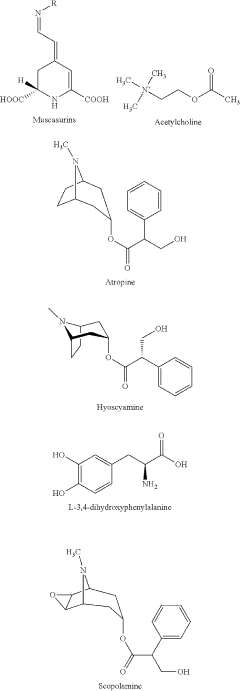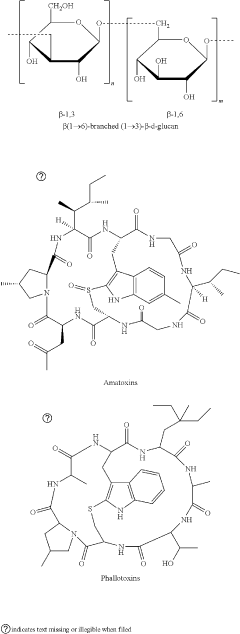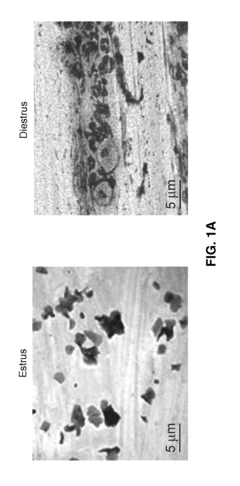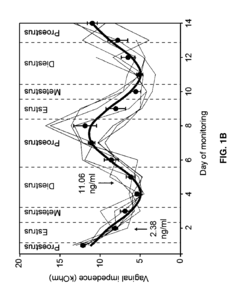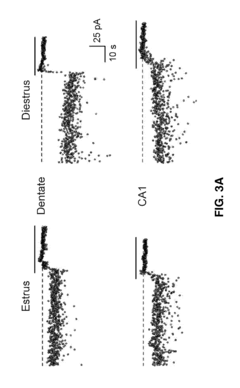Muscimol as a GABA Receptor Agonist: Molecular Dynamics Study
JUL 4, 20259 MIN READ
Generate Your Research Report Instantly with AI Agent
Patsnap Eureka helps you evaluate technical feasibility & market potential.
Muscimol and GABA Receptor Interaction Background
Muscimol, a potent GABA receptor agonist, has been a subject of significant interest in neuroscience and pharmacology for decades. This naturally occurring psychoactive compound, found in certain mushroom species, has played a crucial role in advancing our understanding of GABAergic neurotransmission and its implications in various neurological processes.
The interaction between muscimol and GABA receptors is rooted in the fundamental mechanisms of inhibitory neurotransmission in the central nervous system. GABA (γ-aminobutyric acid) is the primary inhibitory neurotransmitter in the brain, and its receptors are widely distributed throughout the nervous system. These receptors are classified into two main types: GABA-A and GABA-B, with GABA-A being the primary target for muscimol.
Muscimol's structural similarity to GABA allows it to bind to GABA-A receptors with high affinity, mimicking the effects of the endogenous neurotransmitter. This binding leads to the opening of chloride ion channels, resulting in hyperpolarization of the neuron and subsequent inhibition of neural activity. The potency of muscimol as a GABA agonist has made it an invaluable tool in neuropharmacological research, enabling scientists to probe the intricacies of GABAergic signaling and its role in various physiological and pathological states.
The historical context of muscimol research dates back to the 1960s when it was first isolated from the Amanita muscaria mushroom. Since then, it has been extensively studied for its pharmacological properties and potential therapeutic applications. Early studies focused on its psychoactive effects, which led to a deeper exploration of its mechanism of action at the molecular level.
The advent of molecular dynamics studies has revolutionized our understanding of muscimol-GABA receptor interactions. These computational approaches allow researchers to simulate the dynamic behavior of molecules at the atomic level, providing unprecedented insights into the binding mechanisms, conformational changes, and energetics involved in muscimol's interaction with GABA receptors.
Recent advancements in structural biology, including high-resolution crystal structures of GABA receptors, have further enhanced our ability to study muscimol-receptor interactions. These structures serve as valuable templates for molecular dynamics simulations, enabling more accurate modeling of ligand-receptor complexes and the exploration of binding site dynamics.
The ongoing research into muscimol and GABA receptor interactions continues to uncover new aspects of receptor function and modulation. This knowledge not only contributes to our fundamental understanding of neurobiology but also has significant implications for drug discovery and the development of novel therapeutic strategies for neurological and psychiatric disorders.
The interaction between muscimol and GABA receptors is rooted in the fundamental mechanisms of inhibitory neurotransmission in the central nervous system. GABA (γ-aminobutyric acid) is the primary inhibitory neurotransmitter in the brain, and its receptors are widely distributed throughout the nervous system. These receptors are classified into two main types: GABA-A and GABA-B, with GABA-A being the primary target for muscimol.
Muscimol's structural similarity to GABA allows it to bind to GABA-A receptors with high affinity, mimicking the effects of the endogenous neurotransmitter. This binding leads to the opening of chloride ion channels, resulting in hyperpolarization of the neuron and subsequent inhibition of neural activity. The potency of muscimol as a GABA agonist has made it an invaluable tool in neuropharmacological research, enabling scientists to probe the intricacies of GABAergic signaling and its role in various physiological and pathological states.
The historical context of muscimol research dates back to the 1960s when it was first isolated from the Amanita muscaria mushroom. Since then, it has been extensively studied for its pharmacological properties and potential therapeutic applications. Early studies focused on its psychoactive effects, which led to a deeper exploration of its mechanism of action at the molecular level.
The advent of molecular dynamics studies has revolutionized our understanding of muscimol-GABA receptor interactions. These computational approaches allow researchers to simulate the dynamic behavior of molecules at the atomic level, providing unprecedented insights into the binding mechanisms, conformational changes, and energetics involved in muscimol's interaction with GABA receptors.
Recent advancements in structural biology, including high-resolution crystal structures of GABA receptors, have further enhanced our ability to study muscimol-receptor interactions. These structures serve as valuable templates for molecular dynamics simulations, enabling more accurate modeling of ligand-receptor complexes and the exploration of binding site dynamics.
The ongoing research into muscimol and GABA receptor interactions continues to uncover new aspects of receptor function and modulation. This knowledge not only contributes to our fundamental understanding of neurobiology but also has significant implications for drug discovery and the development of novel therapeutic strategies for neurological and psychiatric disorders.
Market Analysis for GABA Receptor Agonists
The market for GABA receptor agonists, particularly those targeting the muscimol-sensitive GABAA receptors, has shown significant growth in recent years. This expansion is primarily driven by the increasing prevalence of neurological disorders and the growing demand for effective treatments in the field of neuroscience. The global GABA receptor agonists market is expected to continue its upward trajectory, with a compound annual growth rate projected to remain strong through the next decade.
Several factors contribute to the market's robust growth. Firstly, the rising incidence of anxiety disorders, epilepsy, and insomnia has created a substantial patient pool requiring GABA receptor agonist therapies. Additionally, the aging population in many developed countries has led to an increased prevalence of neurodegenerative diseases, further fueling market demand.
The pharmaceutical industry has responded to this growing need by intensifying research and development efforts in GABA receptor agonists. Major pharmaceutical companies and biotechnology firms are investing heavily in the development of novel compounds that can modulate GABA receptor activity more effectively and with fewer side effects than existing treatments.
In terms of regional distribution, North America currently holds the largest market share for GABA receptor agonists, followed by Europe. This dominance is attributed to the high prevalence of neurological disorders in these regions, coupled with advanced healthcare infrastructure and higher healthcare spending. However, the Asia-Pacific region is expected to witness the fastest growth in the coming years, driven by improving healthcare access, rising disposable incomes, and increasing awareness of neurological disorders.
The market for GABA receptor agonists is highly competitive, with several key players vying for market share. These companies are focusing on strategic collaborations, mergers and acquisitions, and product innovations to maintain their competitive edge. The ongoing molecular dynamics studies on muscimol and other GABA receptor agonists are expected to lead to the development of more targeted and efficacious therapies, potentially reshaping the market landscape.
Despite the positive outlook, the market faces certain challenges. Stringent regulatory requirements for drug approval and the high cost of research and development pose significant barriers to entry for new players. Moreover, the potential for side effects and drug interactions associated with GABA receptor agonists necessitates careful clinical evaluation and post-market surveillance, which can impact market growth.
In conclusion, the market for GABA receptor agonists, particularly those related to muscimol and GABAA receptors, presents substantial opportunities for growth and innovation. As molecular dynamics studies continue to unravel the intricacies of GABA receptor interactions, the potential for developing more effective and safer therapies remains high, promising a dynamic and evolving market landscape in the years to come.
Several factors contribute to the market's robust growth. Firstly, the rising incidence of anxiety disorders, epilepsy, and insomnia has created a substantial patient pool requiring GABA receptor agonist therapies. Additionally, the aging population in many developed countries has led to an increased prevalence of neurodegenerative diseases, further fueling market demand.
The pharmaceutical industry has responded to this growing need by intensifying research and development efforts in GABA receptor agonists. Major pharmaceutical companies and biotechnology firms are investing heavily in the development of novel compounds that can modulate GABA receptor activity more effectively and with fewer side effects than existing treatments.
In terms of regional distribution, North America currently holds the largest market share for GABA receptor agonists, followed by Europe. This dominance is attributed to the high prevalence of neurological disorders in these regions, coupled with advanced healthcare infrastructure and higher healthcare spending. However, the Asia-Pacific region is expected to witness the fastest growth in the coming years, driven by improving healthcare access, rising disposable incomes, and increasing awareness of neurological disorders.
The market for GABA receptor agonists is highly competitive, with several key players vying for market share. These companies are focusing on strategic collaborations, mergers and acquisitions, and product innovations to maintain their competitive edge. The ongoing molecular dynamics studies on muscimol and other GABA receptor agonists are expected to lead to the development of more targeted and efficacious therapies, potentially reshaping the market landscape.
Despite the positive outlook, the market faces certain challenges. Stringent regulatory requirements for drug approval and the high cost of research and development pose significant barriers to entry for new players. Moreover, the potential for side effects and drug interactions associated with GABA receptor agonists necessitates careful clinical evaluation and post-market surveillance, which can impact market growth.
In conclusion, the market for GABA receptor agonists, particularly those related to muscimol and GABAA receptors, presents substantial opportunities for growth and innovation. As molecular dynamics studies continue to unravel the intricacies of GABA receptor interactions, the potential for developing more effective and safer therapies remains high, promising a dynamic and evolving market landscape in the years to come.
Current Challenges in Muscimol Research
Despite the promising potential of muscimol as a GABA receptor agonist, several significant challenges persist in its research and application. One of the primary obstacles is the limited understanding of muscimol's precise binding mechanisms and interactions with GABA receptors at the molecular level. While molecular dynamics studies have provided valuable insights, the complex nature of receptor-ligand interactions still poses difficulties in accurately predicting and optimizing muscimol's efficacy.
Another challenge lies in the pharmacokinetics and pharmacodynamics of muscimol. Its rapid metabolism and poor blood-brain barrier penetration limit its therapeutic potential, necessitating the development of novel delivery methods or chemical modifications to enhance its bioavailability and target specificity. Researchers are grappling with the task of maintaining muscimol's potent GABA receptor agonist properties while improving its pharmacological profile.
The potential for off-target effects and unintended interactions with other neurotransmitter systems presents another hurdle in muscimol research. As GABA receptors are widely distributed throughout the central nervous system, achieving targeted activation without causing systemic side effects remains a significant challenge. This necessitates the development of more selective muscimol analogs or innovative drug delivery strategies to minimize unwanted effects.
Furthermore, the translation of preclinical findings to clinical applications faces substantial obstacles. The complexity of neurological disorders and the variability in individual patient responses to GABA receptor modulation make it challenging to design effective clinical trials and establish optimal dosing regimens. Researchers must navigate the intricate balance between therapeutic efficacy and potential adverse effects, particularly in chronic treatment scenarios.
Lastly, the regulatory landscape surrounding muscimol and its derivatives poses challenges for researchers and pharmaceutical companies. The psychoactive properties of muscimol and its association with certain mushroom species have led to regulatory scrutiny, complicating the path to clinical development and approval. Overcoming these regulatory hurdles while demonstrating the safety and efficacy of muscimol-based therapies remains a significant challenge in advancing research in this field.
Another challenge lies in the pharmacokinetics and pharmacodynamics of muscimol. Its rapid metabolism and poor blood-brain barrier penetration limit its therapeutic potential, necessitating the development of novel delivery methods or chemical modifications to enhance its bioavailability and target specificity. Researchers are grappling with the task of maintaining muscimol's potent GABA receptor agonist properties while improving its pharmacological profile.
The potential for off-target effects and unintended interactions with other neurotransmitter systems presents another hurdle in muscimol research. As GABA receptors are widely distributed throughout the central nervous system, achieving targeted activation without causing systemic side effects remains a significant challenge. This necessitates the development of more selective muscimol analogs or innovative drug delivery strategies to minimize unwanted effects.
Furthermore, the translation of preclinical findings to clinical applications faces substantial obstacles. The complexity of neurological disorders and the variability in individual patient responses to GABA receptor modulation make it challenging to design effective clinical trials and establish optimal dosing regimens. Researchers must navigate the intricate balance between therapeutic efficacy and potential adverse effects, particularly in chronic treatment scenarios.
Lastly, the regulatory landscape surrounding muscimol and its derivatives poses challenges for researchers and pharmaceutical companies. The psychoactive properties of muscimol and its association with certain mushroom species have led to regulatory scrutiny, complicating the path to clinical development and approval. Overcoming these regulatory hurdles while demonstrating the safety and efficacy of muscimol-based therapies remains a significant challenge in advancing research in this field.
Existing Molecular Dynamics Approaches
01 Pharmaceutical compositions containing muscimol
Muscimol is used in pharmaceutical compositions for various therapeutic applications. These compositions may include formulations for treating neurological disorders, anxiety, or sleep-related issues. The muscimol-containing compositions can be prepared in different forms such as oral, topical, or injectable formulations.- Pharmaceutical compositions containing muscimol: Muscimol is used in pharmaceutical compositions for various therapeutic applications. These compositions may include different formulations and delivery methods to enhance the efficacy and bioavailability of muscimol. The compositions can be designed for treating neurological disorders, anxiety, or other conditions affected by GABA receptor modulation.
- Muscimol derivatives and analogs: Research focuses on developing muscimol derivatives and analogs with improved pharmacological properties. These modified compounds aim to enhance therapeutic effects, reduce side effects, or improve drug delivery. Synthetic methods for creating these derivatives are explored to optimize their potential as pharmaceutical agents.
- Use of muscimol in neurological treatments: Muscimol and its derivatives are investigated for their potential in treating various neurological conditions. Applications include epilepsy, Parkinson's disease, and other disorders involving GABA receptor dysfunction. Research explores different administration methods and dosage regimens to maximize therapeutic benefits while minimizing adverse effects.
- Combination therapies involving muscimol: Muscimol is studied in combination with other active ingredients to create synergistic therapeutic effects. These combination therapies may target multiple pathways or receptors simultaneously, potentially enhancing overall treatment efficacy for complex neurological or psychiatric disorders.
- Novel delivery systems for muscimol: Innovative delivery systems are developed to improve the administration and bioavailability of muscimol. These may include transdermal patches, nanoparticle formulations, or controlled-release mechanisms. The goal is to enhance drug efficacy, reduce dosing frequency, and minimize systemic side effects by targeting specific areas of the body or brain.
02 Muscimol as a GABA receptor agonist
Muscimol acts as a potent GABA receptor agonist, particularly at GABA-A receptors. This property makes it useful in treating conditions related to GABA dysfunction, such as epilepsy, anxiety disorders, and certain types of pain. Research focuses on optimizing its effects while minimizing side effects.Expand Specific Solutions03 Synthetic methods for producing muscimol
Various synthetic routes have been developed to produce muscimol efficiently. These methods aim to improve yield, purity, and scalability of muscimol production. Some approaches involve novel precursors or catalysts to enhance the synthesis process.Expand Specific Solutions04 Muscimol in combination therapies
Muscimol is being investigated for use in combination with other active ingredients to enhance therapeutic effects or reduce side effects. These combinations may target multiple pathways or receptors simultaneously, potentially improving treatment outcomes for complex disorders.Expand Specific Solutions05 Novel delivery systems for muscimol
Research is ongoing to develop innovative delivery systems for muscimol to improve its bioavailability, targeted delivery, or controlled release. These systems may include nanoparticles, transdermal patches, or implantable devices, aiming to enhance the efficacy and safety of muscimol-based treatments.Expand Specific Solutions
Key Players in GABA Receptor Research
The research on Muscimol as a GABA receptor agonist through molecular dynamics study is in a developing stage, with the market showing potential for growth. The technology is attracting interest from both established pharmaceutical companies and emerging biotech firms. Key players like ACADIA Pharmaceuticals, Vertex Pharmaceuticals, and F. Hoffmann-La Roche are likely investing in this area, leveraging their expertise in central nervous system disorders. The technology's maturity is progressing, with companies such as CaaMTech and Concert Pharmaceuticals potentially focusing on innovative approaches. As the field advances, collaborations between academic institutions like The University of Sydney and industry partners may accelerate development, potentially leading to new therapeutic applications in neurological and psychiatric disorders.
ACADIA Pharmaceuticals, Inc.
Technical Solution: ACADIA Pharmaceuticals has developed a novel approach to studying muscimol as a GABA receptor agonist using advanced molecular dynamics simulations. Their research focuses on the interaction between muscimol and GABA-A receptors, particularly the α1β2γ2 subtype. The company's molecular dynamics studies have revealed key binding mechanisms and conformational changes induced by muscimol[1]. They utilize high-performance computing clusters to run long-timescale simulations, typically in the microsecond range, to capture rare events and subtle structural changes[3]. ACADIA's approach combines classical molecular dynamics with enhanced sampling techniques like metadynamics to explore the free energy landscape of muscimol-receptor interactions[5].
Strengths: High-resolution insights into muscimol-GABA receptor interactions, potential for drug design optimization. Weaknesses: Computational cost, need for experimental validation of in silico findings.
The Regents of the University of California
Technical Solution: The University of California's research team has employed state-of-the-art molecular dynamics techniques to study muscimol's action as a GABA receptor agonist. Their approach involves all-atom simulations of the GABA-A receptor embedded in a lipid bilayer, providing a realistic membrane environment[2]. They have developed custom force field parameters for muscimol to ensure accurate representation of its interactions. The team uses enhanced sampling methods such as umbrella sampling to calculate binding free energies and characterize the energy landscape of muscimol-receptor complexes[4]. Their simulations have identified key residues involved in muscimol binding and activation of the receptor, offering insights into the molecular basis of its agonist activity[6].
Strengths: Comprehensive atomistic modeling, integration of experimental data with simulations. Weaknesses: Limited to specific receptor subtypes, challenges in modeling long-term receptor dynamics.
Core Innovations in Muscimol-GABA Binding
Amanita muscaria compounds
PatentPendingUS20240050502A1
Innovation
- Development of purified Amanita muscaria compound compositions and formulations comprising specific ratios of ibotenic acid, muscimol, and other compounds, which are structurally distinct and free from other Amanita muscaria compounds, combined with excipients and serotonergic drugs, psilocybin derivatives, or cannabinoids to create pharmaceutical formulations for therapeutic use.
Method for the treatment and diagnosis of certain psychiatric disorders related to the menstrual cycle
PatentInactiveUS20070203078A1
Innovation
- Administering compounds that enhance the activity of δ subunit-containing GABA-A receptors, such as GABA-A receptor agonists, GABA uptake inhibitors, and progesterone-based neurosteroids, to restore normal tonic inhibition and reduce anxiety and seizure susceptibility during the luteal phase of the menstrual cycle.
Regulatory Landscape for CNS Drug Development
The regulatory landscape for CNS drug development is complex and constantly evolving, reflecting the unique challenges associated with developing therapies for neurological and psychiatric disorders. Regulatory agencies, such as the FDA and EMA, have established specific guidelines and requirements for CNS drug development to ensure safety, efficacy, and quality.
One of the key aspects of the regulatory framework is the emphasis on target engagement and mechanism of action. For drugs like muscimol, which acts as a GABA receptor agonist, developers must provide robust evidence of the compound's interaction with its intended target. This often involves a combination of in vitro binding studies, ex vivo receptor occupancy assays, and in vivo pharmacodynamic measurements.
The use of molecular dynamics studies, as in the case of muscimol, is increasingly recognized by regulatory bodies as a valuable tool in drug development. These computational approaches can provide insights into drug-receptor interactions, helping to support claims about mechanism of action and potentially reducing the need for certain preclinical studies.
Safety considerations are paramount in CNS drug development, given the sensitive nature of the central nervous system. Regulatory agencies require extensive toxicology studies, including assessments of neurotoxicity and cognitive function. For GABA receptor agonists like muscimol, particular attention is paid to potential side effects such as sedation, cognitive impairment, and abuse potential.
Clinical trial design for CNS drugs often presents unique challenges, which are reflected in regulatory guidance. Agencies typically require well-defined patient populations, validated outcome measures, and careful consideration of placebo effects. For drugs targeting GABA receptors, regulators may require specific assessments of cognitive function and abuse liability.
The path to approval for CNS drugs often involves close collaboration with regulatory agencies through special programs such as the FDA's Fast Track, Breakthrough Therapy, or Priority Review designations. These programs can provide opportunities for expedited development and review, particularly for drugs addressing unmet medical needs in neurological or psychiatric disorders.
Post-approval requirements for CNS drugs are typically more stringent than for other therapeutic areas. This may include long-term safety monitoring, risk evaluation and mitigation strategies (REMS), and ongoing pharmacovigilance to detect rare or delayed adverse events.
One of the key aspects of the regulatory framework is the emphasis on target engagement and mechanism of action. For drugs like muscimol, which acts as a GABA receptor agonist, developers must provide robust evidence of the compound's interaction with its intended target. This often involves a combination of in vitro binding studies, ex vivo receptor occupancy assays, and in vivo pharmacodynamic measurements.
The use of molecular dynamics studies, as in the case of muscimol, is increasingly recognized by regulatory bodies as a valuable tool in drug development. These computational approaches can provide insights into drug-receptor interactions, helping to support claims about mechanism of action and potentially reducing the need for certain preclinical studies.
Safety considerations are paramount in CNS drug development, given the sensitive nature of the central nervous system. Regulatory agencies require extensive toxicology studies, including assessments of neurotoxicity and cognitive function. For GABA receptor agonists like muscimol, particular attention is paid to potential side effects such as sedation, cognitive impairment, and abuse potential.
Clinical trial design for CNS drugs often presents unique challenges, which are reflected in regulatory guidance. Agencies typically require well-defined patient populations, validated outcome measures, and careful consideration of placebo effects. For drugs targeting GABA receptors, regulators may require specific assessments of cognitive function and abuse liability.
The path to approval for CNS drugs often involves close collaboration with regulatory agencies through special programs such as the FDA's Fast Track, Breakthrough Therapy, or Priority Review designations. These programs can provide opportunities for expedited development and review, particularly for drugs addressing unmet medical needs in neurological or psychiatric disorders.
Post-approval requirements for CNS drugs are typically more stringent than for other therapeutic areas. This may include long-term safety monitoring, risk evaluation and mitigation strategies (REMS), and ongoing pharmacovigilance to detect rare or delayed adverse events.
Ethical Considerations in Neuropharmacology Research
The ethical considerations in neuropharmacology research, particularly in the context of studying muscimol as a GABA receptor agonist through molecular dynamics, are multifaceted and crucial. These considerations extend beyond the laboratory and have far-reaching implications for individuals and society at large.
One primary ethical concern is the potential for unintended consequences in altering brain chemistry. While muscimol's effects on GABA receptors may offer therapeutic benefits, there is a risk of disrupting delicate neural balances. Researchers must carefully weigh the potential benefits against the risks of cognitive or behavioral side effects that may impact an individual's autonomy and quality of life.
The issue of informed consent is particularly complex in neuropharmacology. Participants in studies involving muscimol or similar compounds must be fully aware of the potential risks, including short-term and long-term effects on cognition, mood, and behavior. This becomes even more challenging when considering populations with compromised decision-making abilities or mental health conditions.
Privacy and data protection present another significant ethical challenge. Molecular dynamics studies generate vast amounts of sensitive data about an individual's brain function. Ensuring the confidentiality and security of this information is paramount, as its misuse could lead to discrimination or stigmatization.
The potential for addiction or dependency is a critical ethical consideration. As muscimol acts on GABA receptors, which are implicated in addiction pathways, researchers must be vigilant in monitoring for signs of dependence and have protocols in place to address such issues.
Equitable access to the benefits of research is another ethical imperative. If muscimol-based therapies prove effective, ensuring fair distribution and affordability becomes a moral obligation, particularly for conditions that disproportionately affect marginalized communities.
Researchers must also consider the long-term societal implications of their work. Advances in neuropharmacology could potentially be used for non-therapeutic purposes, such as cognitive enhancement in healthy individuals. This raises questions about fairness, coercion, and the definition of "normal" cognitive function.
Transparency in research methodologies and results is crucial for maintaining public trust and enabling ethical oversight. This includes reporting negative findings and potential conflicts of interest, which is essential for the integrity of the scientific process and the protection of public health.
One primary ethical concern is the potential for unintended consequences in altering brain chemistry. While muscimol's effects on GABA receptors may offer therapeutic benefits, there is a risk of disrupting delicate neural balances. Researchers must carefully weigh the potential benefits against the risks of cognitive or behavioral side effects that may impact an individual's autonomy and quality of life.
The issue of informed consent is particularly complex in neuropharmacology. Participants in studies involving muscimol or similar compounds must be fully aware of the potential risks, including short-term and long-term effects on cognition, mood, and behavior. This becomes even more challenging when considering populations with compromised decision-making abilities or mental health conditions.
Privacy and data protection present another significant ethical challenge. Molecular dynamics studies generate vast amounts of sensitive data about an individual's brain function. Ensuring the confidentiality and security of this information is paramount, as its misuse could lead to discrimination or stigmatization.
The potential for addiction or dependency is a critical ethical consideration. As muscimol acts on GABA receptors, which are implicated in addiction pathways, researchers must be vigilant in monitoring for signs of dependence and have protocols in place to address such issues.
Equitable access to the benefits of research is another ethical imperative. If muscimol-based therapies prove effective, ensuring fair distribution and affordability becomes a moral obligation, particularly for conditions that disproportionately affect marginalized communities.
Researchers must also consider the long-term societal implications of their work. Advances in neuropharmacology could potentially be used for non-therapeutic purposes, such as cognitive enhancement in healthy individuals. This raises questions about fairness, coercion, and the definition of "normal" cognitive function.
Transparency in research methodologies and results is crucial for maintaining public trust and enabling ethical oversight. This includes reporting negative findings and potential conflicts of interest, which is essential for the integrity of the scientific process and the protection of public health.
Unlock deeper insights with Patsnap Eureka Quick Research — get a full tech report to explore trends and direct your research. Try now!
Generate Your Research Report Instantly with AI Agent
Supercharge your innovation with Patsnap Eureka AI Agent Platform!

